
Dan Wendt, MWRD Staff Photographer
Just swimming with Steve and Matt in the river down by the bridge.
Note of caution... some of the swimsuit photos in this post are not for the faint of heart. Seriously, there are some out-of-shape dudes in here. All photo credits go to Dan Wendt at the Metropolitan Water Reclamation District of Greater Chicago. Good work, Dan!

Eleven perfectly rational people, all of whom value their own lives, set out to jump into the Calumet River. Cuz it's actually pretty clean.
You read the title. Let's just cut to the chase, because you're curious. The water was cool, but not cold, and to be honest, I had expected it to be warmer and less refreshing. It was great. Truly. It was bluish brown, which makes sense because there's a fair amount of sediment. While I saw a few pieces of litter along the shoreline, the open expanse of the river was free of detritus, except for some branches and leaves, like you'd see in any river. An egret followed us from the dock to where we jumped off the pontoon boat. We saw herons, jumping fish and a turtle. Yes, I saw also saw a tire. It didn't bite me.
We each jumped in individually, while about 100 people watched from the terraces of the Blue Island waterfall (or, if you must, the SEPA station). I went under and took several strokes. I never opened my eyes, but I know I got water in my mouth, because I remember spitting some out. Sadly, I have not developed super powers as a result.
After each of us jumped on our own, to much fanfare, we all jumped in again together. And we stayed in the water for a while, splashing around and acting silly, just like we would in any river. We had fun.
In the end, I went for a swim with some buddies in the Calumet River, and then we went and had a beer.

The proud plungers included David St. Pierre, executive director at MWRD; Jason Berry, the planning director at the City of Blue Island; Diane Banta from the National Park Service; and MPC's own Josh Ellis. None of these people are nuts. They all jumped into the Calumet River.
Nobody melted.
It was great, and I look forward to the day it isn't a novelty stunt to raise money and get some media attention. I sincerely believe, as do many other perfectly rational people, that we will be swimming in Chicago's rivers by 2030... which is why that's a specific goal in Our Great Rivers. That's 14 years away, and yes, we need to continue to improve water quality, but we also need swimming infrastructure, safe places out of the way of boats, easy ways to get in and out of the water and so on. But it can happen, and Saturday was proof that we're actually a lot closer than many people seem willing to believe.
Okay, with all that said, let's a step back. Why were we jumping into the Calumet, and why would anyone think we'd melt? What's the big deal?
To the latter part first. Chicago's rivers have a long history of not being very clean. That's an understatement.
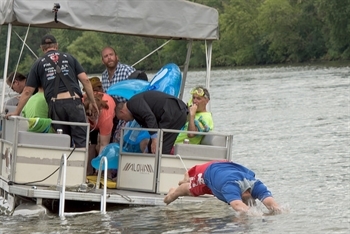
The first one in! David St. Pierre runs a major unit of local government, with a $1 billion budget. There he is diving headfirst into the Calumet.
For the substantial majority of Chicago's history our rivers were filthy. We also didn't have the Internet for most of our history, or a bike share system, or fountains that spit water on people who seem to like it, or... times change, that's the point.
Our rivers can still be much cleaner, but it's no longer 1970. In the decades since the U.S. Clean Water Act of 1974, through investments made by the Metropolitan Water Reclamation District of Greater Chicago, the City of Chicago, Lake County and many suburban communities, we've reduced polluted runoff into our rivers immensely.
We still have too much—I want to make that clear. But things are SO MUCH BETTER THAN THEY WERE.
Judging by some of the headlines touting our Calumet plunge, we still have work to do to convince people of that. There just seem to be people who refuse to believe that change is possible, you know, irregardless of the fact that you can now rent your home online to total strangers, or read e-mail on your watch, or know the DNA of your unborn child, or you know, that we reversed the flow of two whole rivers a century ago. But I digress.

Jason Berry and David St. Pierre watch—in awe I might add—as I begin my flip into the Calumet...
The Calumet is generally cleaner than the Chicago, due in no small part to the completion of the Thornton Reservoir, a major component of the Tunnel and Reservoir Plan. The portion of the system that serves the Chicago River isn't done yet. Even so, portions of the Chicago River are cleaner than others. That said, I don't encourage anyone to go swimming just quite yet. Safe swimming is a combination of high water quality, safe zones away from boat traffic, ladders and other infrastructure for safety, education, etc. Our plunge was a proof of concept more so than an encouragement.

...the flip begins to unravel... Jason is clearly apprehensive...

...and some will I say I stuck the landing, while others will say the landing stuck me. Either way, lots of splash!
So why? Well, partially to show people how far we've come in cleaning up our rivers. And, more immediately, to raise needed funds for the Cal-Sag Trail, a 26-mile trail that follows the Calumet, eventually from Lemont to Burnham. The first dozen miles exists today (you know, even though change is impossible), so go ride it! But the second half is proving trickier, as the communities that will be served by the trail, such as Blue Island or Riverdale, need to generate local funds in order to match federal and state grants. Every single cent we raised on Saturday goes to those local funds. As of writing this, collectively our 11 plungers had raised $17,828, and donations are still being accepted (and encouraged!). It's worth noting that continuous riverfront trails, just like Cal-Sag, are another goal of Our Great Rivers.
I am extremely proud of Jason Berry, my pal and a true champion of the Calumet, for raising $3,763 of that himself. I am also proud of the fact (and grateful) that my friends, family, colleagues and broader network raised $3,036 of that total.
Kudos to Steve Buchtel, from Trails for Illinois, and the Friends of the Cal-Sag Trail for pulling the whole thing together. I'm in for 2017!
But enough jibberjabber. Let's see some more plunges!

The plungers, victorious in fundraising and proving a point, head to the bar.
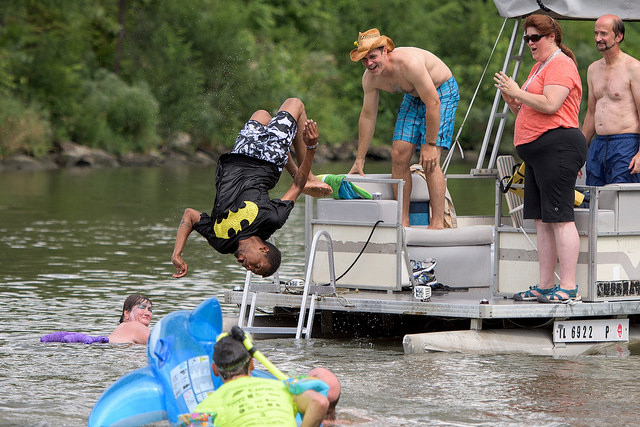
Sergio Green, who works on IT for the Village of Riverdale... at least by day.
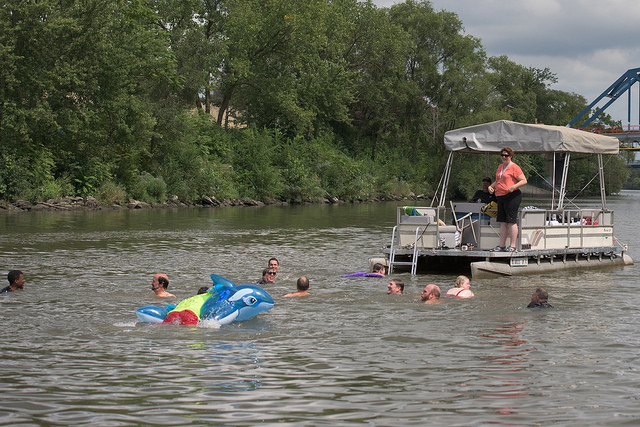
Just a bunch of pals out for a swim. Water looks pretty good to me.
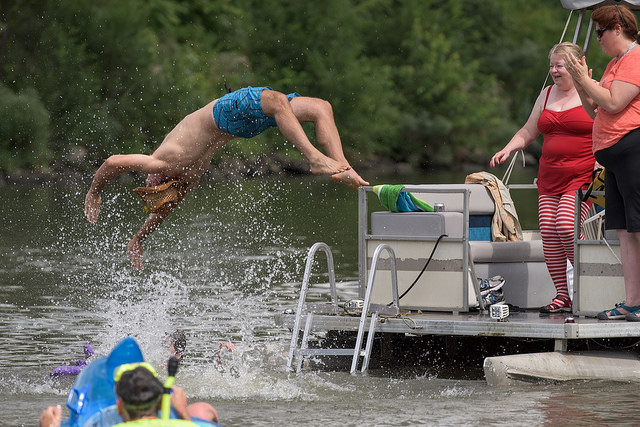
Gavin Van Horn, here clearly showing off, from the Center for Humans and Nature. Showoff.
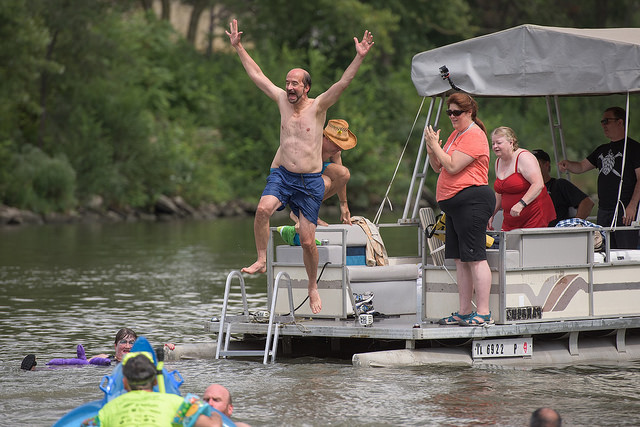
Reggie Greenwood, of the Chicago Southland Economic Development Corporation. Nice form!
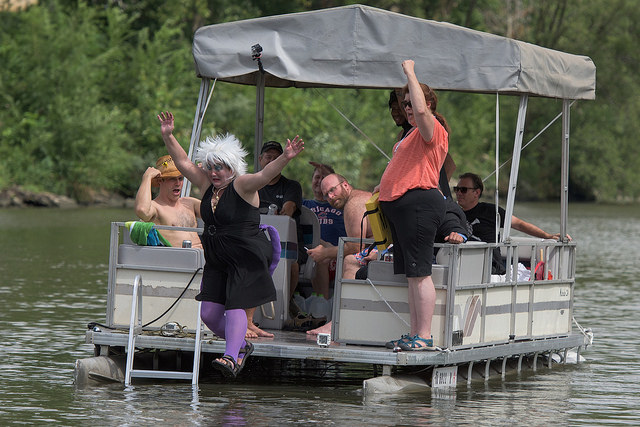
Diane Banta, of the National Park Service, having a grand old time as Ursula, the sea witch from the Little Mermaid